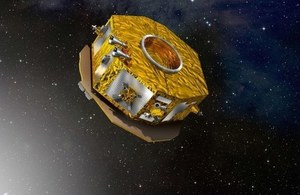A perfectly still laboratory in space
LISA Pathfinder (LISA) has started its mission to test the technology needed to develop future space-borne gravitational wave detectors.

Artist's impression of LISA Pathfinder. Credit: ESA–D. Ducros.
Following a formal review of the commissioning period on 7 March, the mission was formally handed over from the ESA project and industrial teams that built it to the scientists who are now busy carrying out experiments on this unique gravity laboratory in space.
The mission is working exceptionally well, and with every measurement performed on the two freefalling cubes, we are gaining the confidence needed to eventually build the first gravitational wave observatory in space,
says Oliver Jennrich, LISA Pathfinder deputy mission scientist and L3 study scientist at ESA.
Gravitational waves, predicted by Albert Einstein almost a century ago, were recently (11 February 2016) detected for the first time. These mysterious ripples in space-time are thought to be caused by massive celestial events such as neutron stars, black holes or supernovae collisions.
LISA Pathfinder cannot in itself detect gravitational waves – since the impact of gravitational waves is so tiny, the test masses would need to be millions of kilometres apart rather than the 38 cm available on board LISA Pathfinder. LISA Pathfinder must prove the ultra-high precision technology needed to make a test mass float freely in space. This will mean that any effects on its trajectory can only be the result of external gravitational forces. These test masses are two metal cubes which will be placed into gravitational freefall.
Data from future technologies will provide clues about the build-up of structures across the Universe, and especially at early times in cosmic history, when the very first stars and galaxies were taking shape.
The UK’s involvement in LISA Pathfinder’s technology demonstration payload and the operational phase of the mission is funded by the UK Space Agency and was formerly funded by the Science and Technology Facilities Council (STFC). Airbus Defence and Space is the prime contractor for the mission, having built the spacecraft, as well as being the LISA Test Package (LTP) architect, on behalf of ESA and the participating Member States.
SciSys UK Ltd developed the satellite’s on-board software and UK scientists from the University of Birmingham, the University of Glasgow and Imperial College London designed and built elements of the innovative and complex LTP. STFC RAL Space was involved in several technology development projects in the early stages of the mission in 2001.